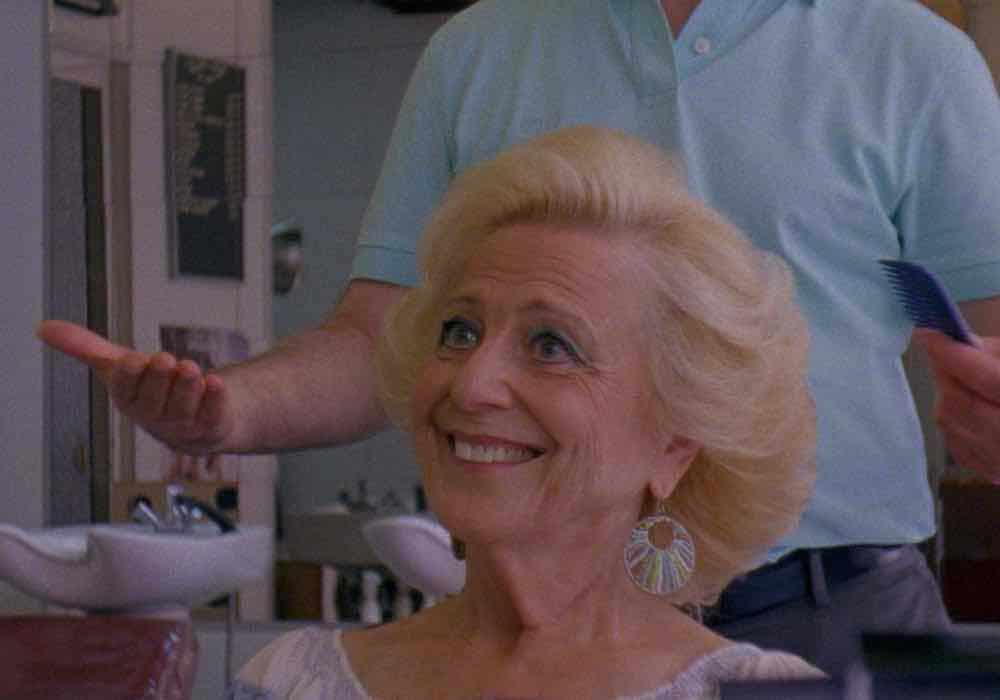Director Sofia Bohdanowicz discusses her process, representing older women in film, and photographing lived in spaces in her new film Maison du Bonheur.

In a lightly accented French, Sofia Bohdanowicz narrates her upcoming journey to Paris, as she packs her bags. In grainy 16 mm, she faces away from the camera as she explains that she is going to live with the mother of a colleague: “Her name is Juliane and she’s an astrologer.” Juliane has lived in the same apartment in Montmartre for decades. For the past fifteen years she has been going to the same woman for her nails and it’s been thirty years she has been visiting the same hair stylist. Over the course of thirty days, Juliane becomes the subject and star of Maison du Bonheur, a series of vignettes on her passions, habits, and memories. It is a film about a life well-lived, a portrait of both a woman and a growing friendship cast in the golden hues of a Parisian summer.
Sofia Bohdanowicz is a Toronto-based filmmaker whose star is rising in the Canadian film scene. Last year, she won the Emerging Canadian Director Award for her feature debut, a micro-budget fiction called Never Eat Alone (2016). Her Last Poems trilogy, a series of shorts about the life and death of her grandmother, were presented in a masterclass at Montreal’s Festival du Nouveau Cinéma in October. Her cinema is inspired by the works of cinema’s great women filmmakers, who searched inward for meaning and towards matriarchal figures for intimate revelations.
At the RIDM Film Festival in Montreal, Sofia Bohdanowicz sat down with The Seventh Row to discuss her process, the representation of women in film, and photographing lived in spaces.
Seventh Row (7R): Before making the film, you had never met Juliane. Did you have an idea of what kind of film you would be making when you went to Paris?
Sofia Bohdanowicz: I had been watching a lot of diaristic films. There is a screening series in Toronto called Early Monthly Segments, and I saw the work of Ute Aurand and some Robert Beavers work, as well. Making a film that is a diary was really interesting to me, something that is just very honest about the day to day. I had an idea that it was going to be a film about whatever I experienced there. Maybe it is a film about me trying to make a film with someone who doesn’t want to be in a film.
I try to be open to whatever variables are there. I’ve learned that if you go into an environment expecting to get something or certain things, I often find that I am really disappointed. Seeing what presents itself to me is a much more interesting way of making a film. It’s riskier. It’s a little bit adventurous. You have to be ready to improvise and go with the flow.
[clickToTweet tweet=”‘My grandmothers helped me become who I am today. I didn’t see those women represented on screen.'” quote=”‘My grandmothers helped me become who I am today. I didn’t see those women represented on screen.'”]
7R: There are moments in the film where you tell Juliane or her sister, for example, “pretend I’m not here”. But you end up including that. Was it always your intention to have yourself as a prominent character in the film?
fia Bohdanowicz: No, it wasn’t, at all. The footage of me packing, at the beginning, was initially just supposed to be a test for the Bolex camera. I bought the Bolex off eBay. I didn’t even know if it worked or not. I was like, “I’m going to shoot a test roll before I go, just to make sure it runs perfectly.”
I was going to send it to the lab, just to make sure it worked. I left myself about a week to do that, but they only process once a month, and it just wasn’t going to get processed on time. The entire time that I was shooting the film, I wasn’t even sure if it was going to work or not. The Bolex sounded fine. I’ve used one before, and it looked fine. There is so much at stake. When it works, it is so miraculous. The image that you get back is really interesting.
[clickToTweet tweet=”‘It’s easier to represent a woman like that as senile or confused, but that’s not the way I see them.'” quote=”‘It’s easier to represent a woman like that as senile or confused, but that’s not the way I see them.'”]
When I started editing the film, I realized the motive behind the entire project was missing: why this woman? This feels artisanal and very hand crafted, but what is the story behind that? I found, in the editing, this is a film very much about Juliane, her life, and her habits. But it was also a story about how our friendship formed and what our relationship was throughout the course of production. It needed that contextualization.
I saw Agnes Varda’s Daguerréotypes, and was like, “Wow! “I feel like she had a lot of the same intentions that I did. I didn’t have the chance to see that film before I made Maison. I wish I did. She just had a child. She couldn’t leave too far from her home, so she would only go as far as this 50 metre cord that she had from her home. She called it the umbilical cord. She would just shoot with her neighbours. At the end of the film, she would talk about how she is unsure what the film is or what its motives were. I thought it was such a beautiful and poetic way to frame a work and to bookend it.
[clickToTweet tweet=”‘Holy shit! You can just make a film that studies a building and what it feels like to be there.'” quote=”‘Holy shit! You can just make a film that studies a building and what it feels like to be there.'”]
7R: I read your that your shooting ratio was almost 1:1: you shot about 90 minutes, and the film is 62 minutes long. How much planning did you do?
Sofia Bohdanowicz: I had 30 rolls. I was going to be there for 30 days. I was going to shoot off one roll every day and one roll will be dedicated to one activity: making bread, driving around Paris, or having lunch at her sister’s house. It would be a way for me to pace myself and breathe. At the nail salon, I used 2 ½ rolls, so then I had to economize with other segments. As my relationship developed with Juliane, we would sit down and have little production meetings. I kept all of my film in her fridge. I would label what it was. We would look in the fridge, and I’d ask, “What else do you want to talk about?” “My Shoes! Or, my makeup!” It became a two-hander where I was asking her, “How do you want tell your story?” She became a collaborator, which was really fun!
[clickToTweet tweet=”‘When I saw HOTEL MONTEREY, when I saw LA CHAMBRE, when I saw JEANNE DIELMAN, it was explosive.'” quote=”‘When I saw HOTEL MONTEREY, when I saw LA CHAMBRE, when I saw JEANNE DIELMAN, it was explosive.'”]
7R: I’ve noticed a lot of your films portray older women that we don’t often see in films. What interests you in portraying their experiences?
Sofia Bohdanowicz: My parents worked hard when I was kid, so I spent a lot of time with my grandmothers. They were strong women that helped me become who I am today. I didn’t see portraits of those women represented on screen. It’s much easier to represent a woman like that as tired, senile or confused, but that’s not the way I see these women.
They have a different pace or way of describing things. That pace isn’t really represented in the way we make films. Filmmakers maybe get frustrated. If you take the time, there is so much rich history there. They’re people who have lived full lives: they’re clever, smart, and fascinating. Discovering this demographic of women, who traditionally haven’t been represented the way they should, was really exciting.
It was exciting for Juliane, too. She has a family that loves her and takes care of her, but day to day, moving through society, no one really wants to sit down and listen to those stories.

7R: In your films, you have a very astute way of shooting space. Without any subjects within the frame you have a sense of an absence or the presence of a life that’s lived. What about this space reflects the person who inhabits it?
Sofia Bohdanowicz: I owe a lot of that confidence to filmmakers like Akerman and Varda, whose work I was deeply moved by. When I saw Hotel Monterey, I was like, “Holy shit! You can just make a film that studies a building and what it looks like and what it feels like to be there.” When I saw that film, when I saw La Chambre, when I saw Jeanne Dielman, it was explosive. It really got me excited. I realized these spaces meant a lot to me.
In photographing my grandmother’s home, I shoot intuitively. It might sound disorganized, but I don’t go with a game-plan. I heard Denis Côté talking about the way he shoots his documentaries. If he has spent a lot of time in a space, the way he is going to shoot might come across as boring. But if he just shows up and starts shooting, something spontaneous might happen. You can feel it in the footage. Hearing that gave me confidence. Going to Juliane’s place, that is what I want to do. I want it to be fresh. I am going in and making those decisions really quickly.
[My short films about] my grandmother’s home were a good study to do ahead of time. It gave me a lot of confidence in developing that cinematic language: “How do I want to tell that story? How do I want to photograph spaces that were familiar to me?” I didn’t plan the way I wanted to shoot, but I knew which parts of those spaces were really personal to me. The hope was that a subjective perspective would translate and people would say to me, “That reminds me of my grandmother’s home.” Which it did! That’s the highest compliment for me.
[clickToTweet tweet=”‘The hope was that people would say to me, “That reminds me of my grandmother’s home.” Which it did!'” quote=”‘The hope was that people would say to me, “That reminds me of my grandmother’s home.” Which it did!'”]
7R: Is your next project your thesis film?
Sofia Bohdanowicz: My thesis film, right now, is based on the life of Kathleen Parlow, who is my grandfather’s mentor. My grandfather was a violinist who played in the Toronto Symphony. [Parlow] was a big Canadian violist, a child prodigy in the early 1900s who had a concerto dedicated to her at the age of 18 by this Norwegian composer in 1908. She did tests with Thomas Edison, and also played the benefit concert for the Titanic when it sank in 1912! She made a lot of significant contributions, was a matriarch in the arts, and she had a lot of pupils. She really helped to add to the cultural identity of Canada.
It’s going to be docu-fiction. We are looking in archives, looking for traces of her, but also pairing it with a narrative line. I don’t want to make a talking head documentary. I like to push those boundaries and limits.

